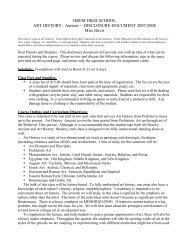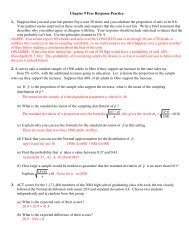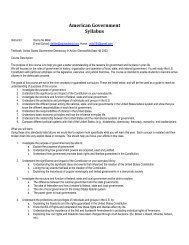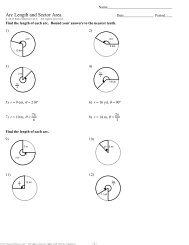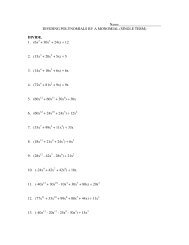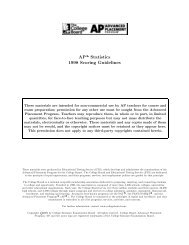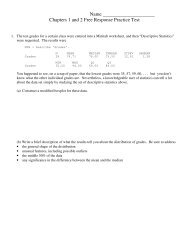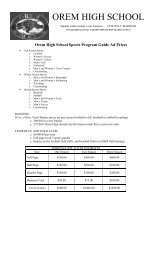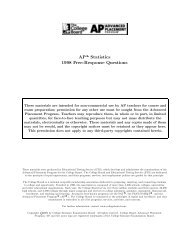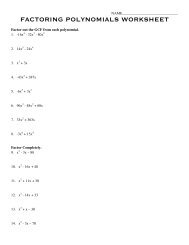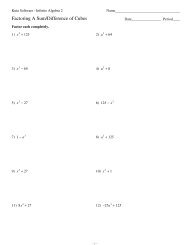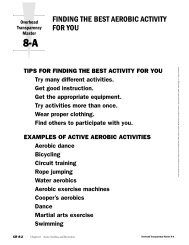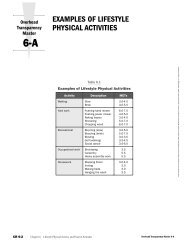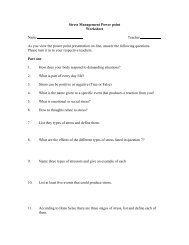PHYSICAL ACTIVITY PYRAMID
PHYSICAL ACTIVITY PYRAMID
PHYSICAL ACTIVITY PYRAMID
You also want an ePaper? Increase the reach of your titles
YUMPU automatically turns print PDFs into web optimized ePapers that Google loves.
Overhead<br />
Transparency<br />
Master<br />
4-A<br />
<strong>PHYSICAL</strong> <strong>ACTIVITY</strong> <strong>PYRAMID</strong><br />
From Fitness for Life Teacher Resources and Materials, Fifth Edition by Karen McConnell, Charles B. Corbin, and Darren Dale, 2005, Champaign, IL: Human Kinetics.<br />
CR 4-2 Chapter 4 How Much Is Enough?<br />
Overhead Transparency Master 4-A
From Fitness for Life Teacher Resources and Materials, Fifth Edition by Karen McConnell, Charles B. Corbin, and Darren Dale, 2005, Champaign, IL: Human Kinetics.<br />
Overhead<br />
Transparency<br />
Master<br />
4-B<br />
FITNESS RATING CATEGORIES<br />
Overhead Transparency Master 4-B<br />
Chapter 4 How Much Is Enough?<br />
CR 4-3
Overhead<br />
Transparency<br />
Master<br />
4-C<br />
GUIDELINES FOR CHOOSING<br />
<strong>PHYSICAL</strong> ACTIVITIES<br />
• Select activities that match your health- and skillrelative<br />
fitness levels.<br />
• Choose activities that meet your interests.<br />
• Select activities that you can do with others.<br />
• Do more than one activity for variety and enjoyment.<br />
• Practice, practice, practice.<br />
• Consider including an activity that does not require<br />
high amounts of skill.<br />
From Fitness for Life Teacher Resources and Materials, Fifth Edition by Karen McConnell, Charles B. Corbin, and Darren Dale, 2005, Champaign, IL: Human Kinetics.<br />
CR 4-4 Chapter 4 How Much Is Enough?<br />
Overhead Transparency Master 4-C
Overhead<br />
Transparency<br />
Master<br />
4-D<br />
FACTORS THAT INFLUENCE<br />
<strong>PHYSICAL</strong> FITNESS<br />
From Fitness for Life Teacher Resources and Materials, Fifth Edition by Karen McConnell, Charles B. Corbin, and Darren Dale, 2005, Champaign, IL: Human Kinetics.<br />
Physical<br />
activity<br />
Age<br />
Factors that influence<br />
physical fitness<br />
Heredity<br />
Environment<br />
Nutrition<br />
Maturation<br />
Other<br />
lifestyles<br />
Overhead Transparency Master 4-D<br />
Chapter 4 How Much Is Enough?<br />
CR 4-5
Name Class Date<br />
Application<br />
4<br />
INFLUENCES ON YOUR <strong>PHYSICAL</strong> FITNESS<br />
Answer the questions below to see what things might influence your physical<br />
fitness level.<br />
1. How do you think you compare to your peers with regard to physical maturation?<br />
____ less physically mature ____ about the same ____ more physically mature<br />
2. Find out the age of five classmates (years and months) and determine if you are younger, older, or about the<br />
same age as your classmates.<br />
Age of person 1: ____ years ____ months<br />
Age of person 2: ____ years ____ months<br />
Age of person 3: ____ years ____ months<br />
Age of person 4: ____ years ____ months<br />
Age of person 5: ____ years ____ months<br />
Your age: ____ years ____ months<br />
How might age differences influence fitness test results?<br />
Average age of all five: ____ years ____ months<br />
_____________________________________________________________________________________<br />
3. What activities do your closest relatives do well? Do you think you inherited any of their athletic skills or<br />
fitness abilities? Which ones?<br />
–––––––––––––––––––––––––––––––––––––––––––––––––––––––––––––––––––––––––––––––––––––<br />
–––––––––––––––––––––––––––––––––––––––––––––––––––––––––––––––––––––––––––––––––––––<br />
4. Are there specific things about your lifestyle that might influence your performance on fitness tests? (For<br />
example, if you smoke, your scores might be lower than a friend who does not smoke.)<br />
–––––––––––––––––––––––––––––––––––––––––––––––––––––––––––––––––––––––––––––––––––––<br />
–––––––––––––––––––––––––––––––––––––––––––––––––––––––––––––––––––––––––––––––––––––<br />
From Fitness for Life Teacher Resources and Materials, Fifth Edition by Karen McConnell, Charles B. Corbin, and Darren Dale, 2005, Champaign, IL: Human Kinetics.<br />
5. Leanna didn’t score as well on her fitness tests in physical education class as she hoped she would. She followed<br />
all of the instructions and rules carefully. Leanna knows that some of the other students are not very physically<br />
active, and she doesn’t understand why her scores are lower than theirs. What are some things that might have<br />
contributed to her lower scores?<br />
–––––––––––––––––––––––––––––––––––––––––––––––––––––––––––––––––––––––––––––––––––––<br />
–––––––––––––––––––––––––––––––––––––––––––––––––––––––––––––––––––––––––––––––––––––<br />
–––––––––––––––––––––––––––––––––––––––––––––––––––––––––––––––––––––––––––––––––––––<br />
–––––––––––––––––––––––––––––––––––––––––––––––––––––––––––––––––––––––––––––––––––––<br />
CR 4-6<br />
Chapter 4 How Much Is Enough?<br />
Application 4 Worksheet
Name Class Date<br />
4<br />
Reinforcement<br />
TRUE-FALSE <strong>PHYSICAL</strong> <strong>ACTIVITY</strong> CLUES<br />
For each statement below, write T in the blank if it is true<br />
and F if it is false.<br />
From Fitness for Life Teacher Resources and Materials, Fifth Edition by Karen McConnell, Charles B. Corbin, and Darren Dale, 2005, Champaign, IL: Human Kinetics.<br />
____<br />
____<br />
____<br />
____<br />
____<br />
____<br />
____<br />
____<br />
____<br />
____<br />
____<br />
____<br />
____<br />
____<br />
____<br />
____<br />
____<br />
1. When you increase your exercise program gradually, you are following the principle of progression.<br />
2. The four factors in the FITT formula are frequency, intensity, time, and type.<br />
3. The intensity of physical activity should be increased quickly so that the body does not have time to adapt<br />
to a particular load.<br />
4. A high performance rating is not a necessity for good health.<br />
5. You can improve your fitness without an increase in exercise.<br />
6. Your resting heart rate is the number of times your heart beats per minute while you are asleep.<br />
7. To check your heart rate during an exercise activity, count your pulse as soon as you finish the activity.<br />
8. A minimum goal should be to achieve high performance in all five parts of health-related fitness.<br />
9. The threshold of training is the minimum amount of overload you need to build physical fitness.<br />
10. The FITT formula can be applied differently for each area of fitness and for each body part.<br />
11. The principle of specificity states that most types of activity build the same parts of fitness.<br />
12. Exercising above your target ceiling is a good way to build fitness fast.<br />
13. An athlete’s chances of success are increased if he or she has an excellent fitness rating.<br />
14. You can tell everything you need to know about your fitness from one physical activity.<br />
15. Maturation can play an important part in a person’s skill-related fitness.<br />
16. For exercise to be of benefit, the frequency needs to remain the same for each kind of exercise.<br />
17. To improve fitness, you must work within your target fitness zone at least 15 to 30 minutes at one time.<br />
The numbers below correspond to the true-false statements. If you black out each letter that corresponds to the<br />
number of a statement that was true, the remaining letters will spell a word from the chapter.<br />
1 2 3 4 5 6 7 8 9 10 11 12 13 14 15 16 17<br />
R N O S V E J R P W L O Z A Q D X<br />
Reinforcement 4 Worksheet<br />
Chapter 4 How Much Is Enough?<br />
CR 4-7
Name Class Date<br />
4<br />
Personal<br />
Project<br />
ONE-WEEK <strong>ACTIVITY</strong> LOG AND PLAN<br />
Part 1: One-week activity log<br />
Use the chart below to log your activities for one week.<br />
From ______ / ______ to ______ / ______.<br />
Month Day Month Day<br />
Day Activity Time of day How long?<br />
Monday<br />
Tuesday<br />
Wednesday<br />
Thursday<br />
Friday<br />
Saturday<br />
Sunday<br />
When during the day do you seem to have the most time and energy?<br />
__________________________________________________________________________________________<br />
During what times would it be easiest for you to participate in regular physical activity?<br />
From Fitness for Life Teacher Resources and Materials, Fifth Edition by Karen McConnell, Charles B. Corbin, and Darren Dale, 2005, Champaign, IL: Human Kinetics.<br />
__________________________________________________________________________________________<br />
__________________________________________________________________________________________<br />
__________________________________________________________________________________________<br />
CR 4-8<br />
Chapter 4 How Much Is Enough?<br />
Personal Project 4 Worksheet
Name Class Date<br />
4<br />
Personal<br />
Project<br />
ONE-WEEK <strong>ACTIVITY</strong> LOG AND PLAN (continued)<br />
Part 2: One-week activity plan<br />
Use the chart below to plan your activities for one week.<br />
From ______ / ______ to ______ / ______.<br />
Month Day Month Day<br />
Day Activity Time of day How long?<br />
From Fitness for Life Teacher Resources and Materials, Fifth Edition by Karen McConnell, Charles B. Corbin, and Darren Dale, 2005, Champaign, IL: Human Kinetics.<br />
Monday<br />
Tuesday<br />
Wednesday<br />
Thursday<br />
Friday<br />
Saturday<br />
Sunday<br />
Were you able to perform your activities as planned? Why or why not?<br />
__________________________________________________________________________________________<br />
__________________________________________________________________________________________<br />
__________________________________________________________________________________________<br />
__________________________________________________________________________________________<br />
Personal Project 4 Worksheet<br />
Chapter 4 How Much Is Enough?<br />
CR 4-9
Name Class Date<br />
4<br />
Chapter Test<br />
HOW MUCH IS ENOUGH?<br />
Choose the letter of the best answer for questions 1-14.<br />
Use what you learned throughout the chapter to answer the final question.<br />
1. The principle of overload states that<br />
a. it is foolish to exercise too much or too often.<br />
b. exercising more than you normally do<br />
improves fitness.<br />
c. decreasing regular exercise improves fitness.<br />
d. lifting too much weight is harmful.<br />
2. Your correct range of physical activity is your<br />
a. target ceiling. c. target fitness zone.<br />
b. threshold of training. d. FITNESSGRAM<br />
zone.<br />
3. The minimum amount of overload needed to<br />
build physical fitness is the<br />
a. threshold of training.<br />
b. target fitness zone.<br />
c. principle of specificity.<br />
d. principle of overload.<br />
4. Of the following, the factor that contributes<br />
LEAST to physical fitness is<br />
a. maturation. c. heredity.<br />
b. age. d. height.<br />
5. Intensity means how<br />
a. often a person exercises.<br />
b. long a person exercises.<br />
c. much a person enjoys exercising.<br />
d. hard a person exercises.<br />
6. Which part of the FITT formula relates to how<br />
often a person exercises?<br />
a. type c. frequency<br />
b. intensity d. time<br />
7. When your body adapts to your exercise load,<br />
you should<br />
a. decrease the load slightly.<br />
b. increase the load slightly.<br />
c. change the kind of exercise you are doing.<br />
d. stop exercising.<br />
8. Agility exercise might not have an effect on<br />
muscle strength according to the principle of<br />
a. progression. c. specificity.<br />
b. overloading. d. fitness.<br />
9. People with marginal fitness ratings<br />
a. need to work to reach good fitness ratings.<br />
b. need to maintain those ratings.<br />
c. need to work to reach high-performance fitness<br />
ratings.<br />
d. have less risk of health problems than people<br />
with good fitness ratings.<br />
10. A gradual increase in exercise follows the principle<br />
of<br />
a. progression. c. cardiovascular<br />
b. physical activity. fitness.<br />
d. specificity.<br />
11. An example of an activity at the bottom of the<br />
Physical Activity Pyramid is<br />
a. aerobic exercise such as jogging.<br />
b. active sports such as tennis.<br />
c. lifestyle activity such as yard work.<br />
d. weight training for muscular endurance.<br />
12. Which of the following is the most reasonable<br />
goal for a fitness program for most people?<br />
a. good ratings in three of five health-related<br />
categories<br />
b. high ratings in all health-related categories<br />
c. good ratings in all skill-related categories<br />
d. good ratings in all health-related categories<br />
13. Maturation is LEAST closely related to<br />
a. hormone production.<br />
b. muscle and bone development.<br />
c. becoming fully grown.<br />
d. the amount of activity you do.<br />
14. The upper limit of your physical activity is your<br />
a. target fitness zone. c. threshold ceiling.<br />
b. target ceiling. d. threshold of training.<br />
15. Although sedentary living is discouraged, “rest<br />
or inactivity” is at the top of the Physical Activity<br />
Pyramid. Explain why.<br />
______________________________________<br />
______________________________________<br />
______________________________________<br />
______________________________________<br />
From Fitness for Life Teacher Resources and Materials, Fifth Edition by Karen McConnell, Charles B. Corbin, and Darren Dale, 2005, Champaign, IL: Human Kinetics.<br />
CR 4-10<br />
Chapter 4 How Much Is Enough?<br />
Chapter 4 Test




